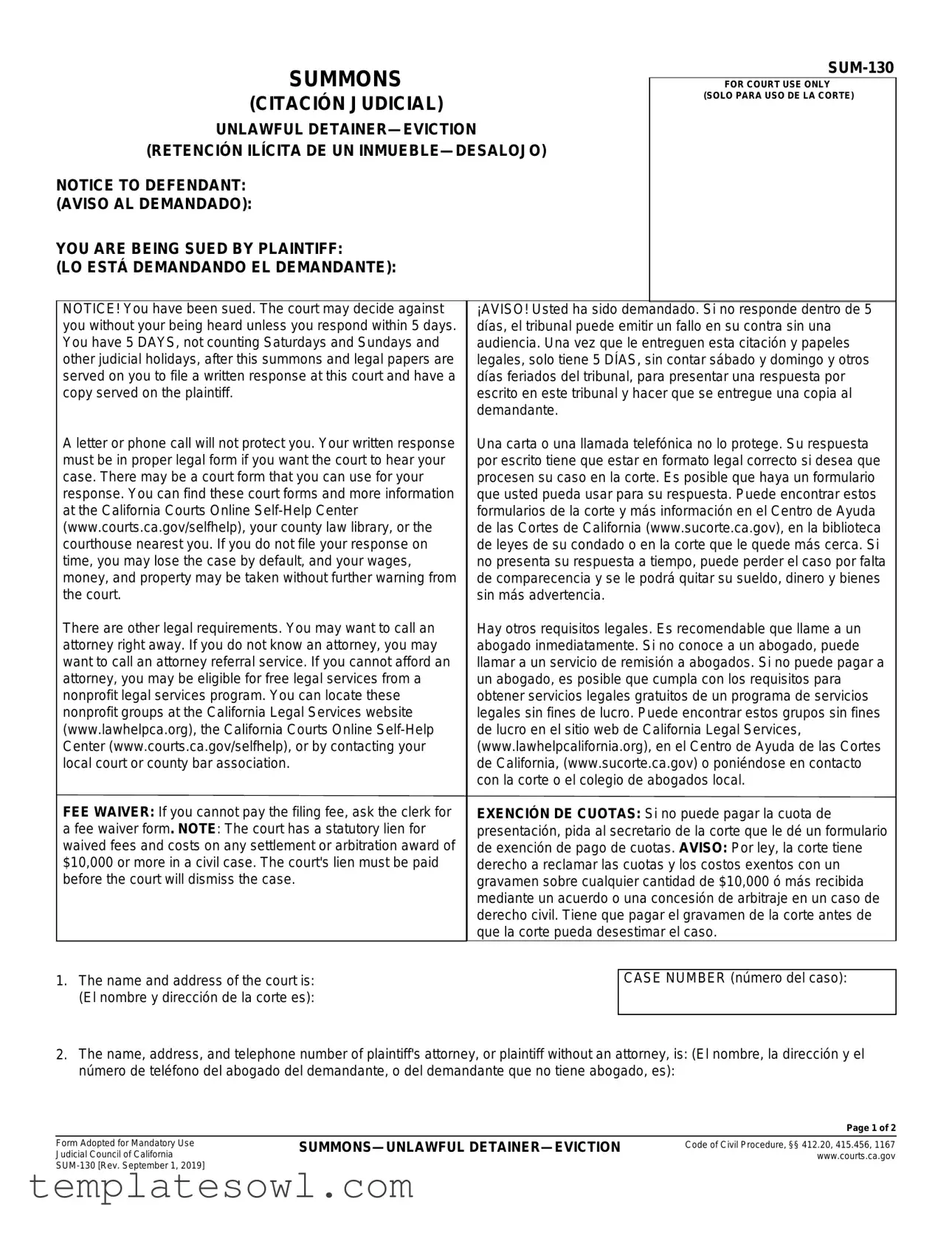SUMMONS |
|
SUM-130 |
|
FOR COURT USE ONLY |
(CITACIÓN JUDICIAL) |
|
(SOLO PARA USO DE LA CORTE) |
|
|
UNLAWFUL DETAINER—EVICTION |
|
|
(RETENCIÓN ILÍCITA DE UN INMUEBLE—DESALOJO) |
|
NOTICE TO DEFENDANT: |
|
|
(AVISO AL DEMANDADO): |
|
|
YOU ARE BEING SUED BY PLAINTIFF: |
|
|
(LO ESTÁ DEMANDANDO EL DEMANDANTE): |
|
|
|
|
|
|
NOTICE! You have been sued. The court may decide against |
|
¡AVISO! Usted ha sido demandado. Si no responde dentro de 5 |
you without your being heard unless you respond within 5 days. |
|
días, el tribunal puede emitir un fallo en su contra sin una |
You have 5 DAYS, not counting Saturdays and Sundays and |
|
audiencia. Una vez que le entreguen esta citación y papeles |
other judicial holidays, after this summons and legal papers are |
|
legales, solo tiene 5 DÍAS, sin contar sábado y domingo y otros |
served on you to file a written response at this court and have a |
|
días feriados del tribunal, para presentar una respuesta por |
copy served on the plaintiff. |
|
escrito en este tribunal y hacer que se entregue una copia al |
|
|
demandante. |
A letter or phone call will not protect you. Your written response |
|
Una carta o una llamada telefónica no lo protege. Su respuesta |
must be in proper legal form if you want the court to hear your |
|
por escrito tiene que estar en formato legal correcto si desea que |
case. There may be a court form that you can use for your |
|
procesen su caso en la corte. Es posible que haya un formulario |
response. You can find these court forms and more information |
|
que usted pueda usar para su respuesta. Puede encontrar estos |
at the California Courts Online Self-Help Center |
|
formularios de la corte y más información en el Centro de Ayuda |
(www.courts.ca.gov/selfhelp), your county law library, or the |
|
de las Cortes de California (www.sucorte.ca.gov), en la biblioteca |
courthouse nearest you. If you do not file your response on |
|
de leyes de su condado o en la corte que le quede más cerca. Si |
time, you may lose the case by default, and your wages, |
|
no presenta su respuesta a tiempo, puede perder el caso por falta |
money, and property may be taken without further warning from |
|
de comparecencia y se le podrá quitar su sueldo, dinero y bienes |
the court. |
|
sin más advertencia. |
There are other legal requirements. You may want to call an |
|
Hay otros requisitos legales. Es recomendable que llame a un |
attorney right away. If you do not know an attorney, you may |
|
abogado inmediatamente. Si no conoce a un abogado, puede |
want to call an attorney referral service. If you cannot afford an |
|
llamar a un servicio de remisión a abogados. Si no puede pagar a |
attorney, you may be eligible for free legal services from a |
|
un abogado, es posible que cumpla con los requisitos para |
nonprofit legal services program. You can locate these |
|
obtener servicios legales gratuitos de un programa de servicios |
nonprofit groups at the California Legal Services website |
|
legales sin fines de lucro. Puede encontrar estos grupos sin fines |
(www.lawhelpca.org), the California Courts Online Self-Help |
|
de lucro en el sitio web de California Legal Services, |
Center (www.courts.ca.gov/selfhelp), or by contacting your |
|
(www.lawhelpcalifornia.org), en el Centro de Ayuda de las Cortes |
local court or county bar association. |
|
de California, (www.sucorte.ca.gov) o poniéndose en contacto |
|
|
con la corte o el colegio de abogados local. |
FEE WAIVER: If you cannot pay the filing fee, ask the clerk for |
|
EXENCIÓN DE CUOTAS: Si no puede pagar la cuota de |
a fee waiver form. NOTE: The court has a statutory lien for |
|
presentación, pida al secretario de la corte que le dé un formulario |
|
waived fees and costs on any settlement or arbitration award of |
|
de exención de pago de cuotas. AVISO: Por ley, la corte tiene |
$10,000 or more in a civil case. The court's lien must be paid |
|
derecho a reclamar las cuotas y los costos exentos con un |
before the court will dismiss the case. |
|
gravamen sobre cualquier cantidad de $10,000 ó más recibida |
|
|
mediante un acuerdo o una concesión de arbitraje en un caso de |
|
|
derecho civil. Tiene que pagar el gravamen de la corte antes de |
|
|
que la corte pueda desestimar el caso. |




 as an individual defendant.
as an individual defendant.
 as the person sued under the fictitious name of
as the person sued under the fictitious name of 
 as an occupant.
as an occupant.
 on behalf of
on behalf of